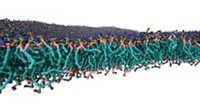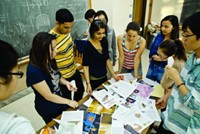Advertisement
Grab your lab coat. Let's get started
Welcome!
Welcome!
Create an account below to get 6 C&EN articles per month, receive newsletters and more - all free.
It seems this is your first time logging in online. Please enter the following information to continue.
As an ACS member you automatically get access to this site. All we need is few more details to create your reading experience.
Not you? Sign in with a different account.
Not you? Sign in with a different account.
ERROR 1
ERROR 1
ERROR 2
ERROR 2
ERROR 2
ERROR 2
ERROR 2
Password and Confirm password must match.
If you have an ACS member number, please enter it here so we can link this account to your membership. (optional)
ERROR 2
ACS values your privacy. By submitting your information, you are gaining access to C&EN and subscribing to our weekly newsletter. We use the information you provide to make your reading experience better, and we will never sell your data to third party members.
Education
Modernizing Chem Engineering
Database helps chemical engineering professors inject biotechnology into undergraduate core curriculum
by Celia Henry Arnaud
October 15, 2007
| A version of this story appeared in
Volume 85, Issue 42
"MORE AND MORE chemical engineers graduating now are going into biotechnology or biobased jobs," says Claire F. Komives, a chemical engineering professor at San Jose State University. In many cases, however, chemical engineering education hasn't been updated to include the biology-related training these job candidates require. "The current curriculum doesn't really address those needs except where you have faculty with a biology background who add that type of material" on their own initiative, Komives says.
Komives and Erik J. Fernandez, a chemical engineering professor at the University of Virginia, set out to remedy this deficiency by creating the Bioengineering Educational Materials Bank (BioEMB). This new online resource is being designed to help chemical engineering professors, especially those with no biology or biotechnology background, include biotech examples in their introductory courses, even if their textbooks don't.
"Chemical engineering has a well-defined set of core principles that need to be taught and learned," Fernandez says. Many of the classic textbooks that are still widely used in introductory chemical engineering classes don't include modern chemical engineering applications such as biotechnology and microelectronics to teach those principles.
"There's been a desire to get biotechnology into the curriculum for quite some time now," Fernandez notes, "but there's a very high barrier to writing textbooks." BioEMB is a practical way to inject such material into courses without waiting for a textbook.
The project's leaders are collecting, creating, and reviewing problems that professors can then use. So far, Fernandez and Komives have focused on material and energy balance, which is often the subject of the first course in the chemical engineering core curriculum. They plan to add problems relevant to other courses as funding becomes available.
The pair hatched the idea for BioEMB after listening to a panel discussion at a symposium about educational issues in biotechnology at an American Chemical Society national meeting in 2004. The project moved forward slowly at first, only shifting into high gear after Fernandez and Komives received a grant from the National Science Foundation in January 2007.
The material is available on the Web at www.bioEMB.net. Problems are organized so that an instructor can easily see where they fit with two of the most commonly used textbooks for the material and energy balance course: "Elementary Principles of Chemical Processes" by Richard M. Felder and Ronald W. Rousseau and "Basic Principles and Calculations in Chemical Engineering" by David M. Himmelblau and James B. Riggs.
Fernandez and Komives are looking for creative professors to contribute to the growing database. The collection got a huge jump-start when chemical engineering professor Todd Przybycien of Carnegie Mellon University contributed an entire year's worth of problems. But they still want more, and they invite prospective contributors to submit problems through the website.
In addition to the website, Komives and Fernandez organized a July workshop at San Jose State to help professors become comfortable with the biology-related material. A single e-mail announcement to the listserv for chemical engineering department chairs filled the workshop.
THE WORKSHOP started with a crash course in molecular biology and biotech applications, then moved on to a session on active learning techniques. Finally, the participants solved problems that had already been submitted or created.
Getting professors to solve the problems helped Komives and Fernandez clarify an issue they've been wrestling with: How much biology do chemical engineering professors need to know to teach these applications?
As professors worked through the problems, Komives and Fernandez were able to see what concepts were new for the faculty. They then developed and posted a "road map" document to serve as a tutorial for the nonbiology faculty to better understand how to apply chemical engineering concepts to biological problems.
They plan to have all the problems peer-reviewed. Chemical engineers in traditional areas will assess how understandable the problems are, whereas the biologically trained engineers will review them for accuracy.
Currently, four universities are serving as beta sites to test the effectiveness of the problems and the approach. Komives and Fernandez are asking the faculty to use the problems in the place of some of the homework problems they would normally assign.
At the end of their courses, participating professors will "donate" one class period for the students to take a mock exam. The exam results will be compared with those of students from sections that didn't use the BioEMB problems. The mock exam will also compare the effectiveness of problems that cover the same engineering principles with and without a biological context.
Komives and Fernandez hope that BioEMB will help professors better prepare and motivate their students for the future of chemical engineering. "If you can tell a student that an example was taken from a real process for a drug that just came out to cure this disease, that's much more motivating than 'A goes to B; tell me the rate constant,' " Fernandez says.







Join the conversation
Contact the reporter
Submit a Letter to the Editor for publication
Engage with us on Twitter